Fraud Risk Factors in System Replacement
VerifiedAdded on 2020/03/02
|10
|2643
|113
AI Summary
This assignment analyzes a scenario where a company abruptly replaces its existing accounting system due to concerns about data transfer during the transition. The analysis highlights potential fraud risks associated with this decision, suggesting that management might be attempting to conceal fraudulent activities by claiming transaction losses due to incompetence or inefficiency within the accounting and IT departments. The new system presents an opportunity for employees to exploit compromised accounts for personal gain, further exacerbating the risk of financial misconduct.
Contribute Materials
Your contribution can guide someone’s learning journey. Share your
documents today.
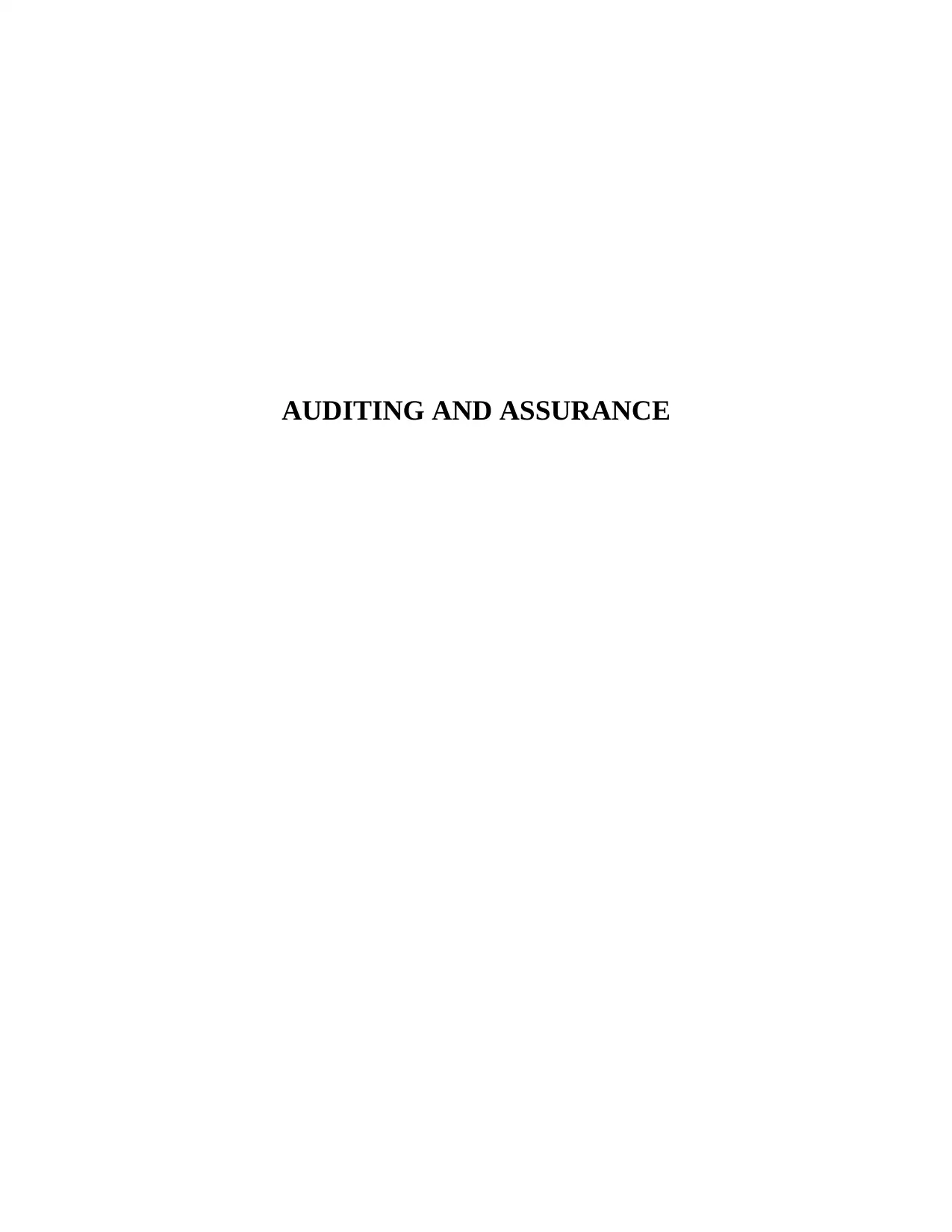
AUDITING AND ASSURANCE
Secure Best Marks with AI Grader
Need help grading? Try our AI Grader for instant feedback on your assignments.
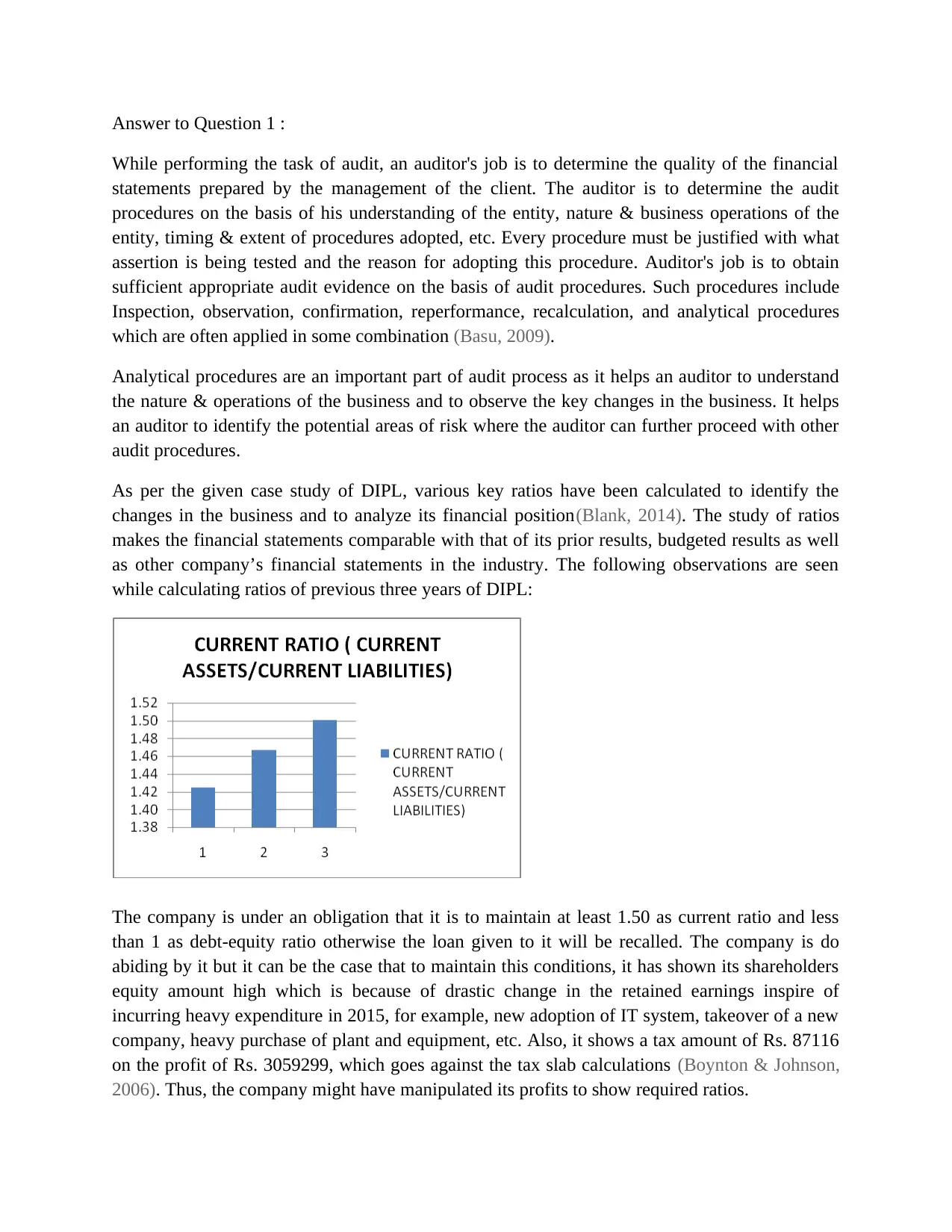
Answer to Question 1 :
While performing the task of audit, an auditor's job is to determine the quality of the financial
statements prepared by the management of the client. The auditor is to determine the audit
procedures on the basis of his understanding of the entity, nature & business operations of the
entity, timing & extent of procedures adopted, etc. Every procedure must be justified with what
assertion is being tested and the reason for adopting this procedure. Auditor's job is to obtain
sufficient appropriate audit evidence on the basis of audit procedures. Such procedures include
Inspection, observation, confirmation, reperformance, recalculation, and analytical procedures
which are often applied in some combination (Basu, 2009).
Analytical procedures are an important part of audit process as it helps an auditor to understand
the nature & operations of the business and to observe the key changes in the business. It helps
an auditor to identify the potential areas of risk where the auditor can further proceed with other
audit procedures.
As per the given case study of DIPL, various key ratios have been calculated to identify the
changes in the business and to analyze its financial position(Blank, 2014). The study of ratios
makes the financial statements comparable with that of its prior results, budgeted results as well
as other company’s financial statements in the industry. The following observations are seen
while calculating ratios of previous three years of DIPL:
The company is under an obligation that it is to maintain at least 1.50 as current ratio and less
than 1 as debt-equity ratio otherwise the loan given to it will be recalled. The company is do
abiding by it but it can be the case that to maintain this conditions, it has shown its shareholders
equity amount high which is because of drastic change in the retained earnings inspire of
incurring heavy expenditure in 2015, for example, new adoption of IT system, takeover of a new
company, heavy purchase of plant and equipment, etc. Also, it shows a tax amount of Rs. 87116
on the profit of Rs. 3059299, which goes against the tax slab calculations (Boynton & Johnson,
2006). Thus, the company might have manipulated its profits to show required ratios.
While performing the task of audit, an auditor's job is to determine the quality of the financial
statements prepared by the management of the client. The auditor is to determine the audit
procedures on the basis of his understanding of the entity, nature & business operations of the
entity, timing & extent of procedures adopted, etc. Every procedure must be justified with what
assertion is being tested and the reason for adopting this procedure. Auditor's job is to obtain
sufficient appropriate audit evidence on the basis of audit procedures. Such procedures include
Inspection, observation, confirmation, reperformance, recalculation, and analytical procedures
which are often applied in some combination (Basu, 2009).
Analytical procedures are an important part of audit process as it helps an auditor to understand
the nature & operations of the business and to observe the key changes in the business. It helps
an auditor to identify the potential areas of risk where the auditor can further proceed with other
audit procedures.
As per the given case study of DIPL, various key ratios have been calculated to identify the
changes in the business and to analyze its financial position(Blank, 2014). The study of ratios
makes the financial statements comparable with that of its prior results, budgeted results as well
as other company’s financial statements in the industry. The following observations are seen
while calculating ratios of previous three years of DIPL:
The company is under an obligation that it is to maintain at least 1.50 as current ratio and less
than 1 as debt-equity ratio otherwise the loan given to it will be recalled. The company is do
abiding by it but it can be the case that to maintain this conditions, it has shown its shareholders
equity amount high which is because of drastic change in the retained earnings inspire of
incurring heavy expenditure in 2015, for example, new adoption of IT system, takeover of a new
company, heavy purchase of plant and equipment, etc. Also, it shows a tax amount of Rs. 87116
on the profit of Rs. 3059299, which goes against the tax slab calculations (Boynton & Johnson,
2006). Thus, the company might have manipulated its profits to show required ratios.

The cash ratio is being calculated instead of quick ratio as quick ratio excludes only inventory
while cash ratio also excludes depreciation which is actually a non-cash expense thus,
determining the ready cash available within the company. DIPL's cash ratio was 0.89 in 2013 but
it showed an improvement in 2014 by having 1.00 which means that the company had enough
cash available to pay its short term obligations (Cahill & Kane, 2011). However, in the current
year, the cash ratio reduced by almost 8% showing that the company's cash in hand reduced
instantly and that the short term obligations cannot be paid so frequently if in case it has to be
paid.
The return on assets ratio measures how efficiently a company is using its assets to convert it
into profits and revenues. It is important for both the management & investors to know the
return the company is earning as the major investments of a company are in its assets. However,
in this case, the return on assets is decreasing every year,that is, from 18.25% & 14.41% to
while cash ratio also excludes depreciation which is actually a non-cash expense thus,
determining the ready cash available within the company. DIPL's cash ratio was 0.89 in 2013 but
it showed an improvement in 2014 by having 1.00 which means that the company had enough
cash available to pay its short term obligations (Cahill & Kane, 2011). However, in the current
year, the cash ratio reduced by almost 8% showing that the company's cash in hand reduced
instantly and that the short term obligations cannot be paid so frequently if in case it has to be
paid.
The return on assets ratio measures how efficiently a company is using its assets to convert it
into profits and revenues. It is important for both the management & investors to know the
return the company is earning as the major investments of a company are in its assets. However,
in this case, the return on assets is decreasing every year,that is, from 18.25% & 14.41% to

11.37% in 2015. Also, in the current year, % change in assets is more than the double of %
change in net earnings which is not a good sign.
Proprietary ratio is an indication of financial stability of the company, that is, whether the
company has sufficient equity balance to support its operations or not. It indicates whether the
investment made in the company is being properly capitalized or not. In the following case, the
ratio has drastically reduced from 0.71 (2013) & 0.68 (2014) to 0.47 in 2015 meaning that the
company is unable to capitalize its equity investment or it is making more use of its additional
debts, which is not a good sign.
The interest coverage ratio has reduced drastically from 40.94 (2013) & 40.13 (2014) to 4.79 in
2015 indicating that the paying ability of the company is getting weak to bear its interest
expenses. Also, there is a heavy burden of interest expenses on the company.
change in net earnings which is not a good sign.
Proprietary ratio is an indication of financial stability of the company, that is, whether the
company has sufficient equity balance to support its operations or not. It indicates whether the
investment made in the company is being properly capitalized or not. In the following case, the
ratio has drastically reduced from 0.71 (2013) & 0.68 (2014) to 0.47 in 2015 meaning that the
company is unable to capitalize its equity investment or it is making more use of its additional
debts, which is not a good sign.
The interest coverage ratio has reduced drastically from 40.94 (2013) & 40.13 (2014) to 4.79 in
2015 indicating that the paying ability of the company is getting weak to bear its interest
expenses. Also, there is a heavy burden of interest expenses on the company.
Secure Best Marks with AI Grader
Need help grading? Try our AI Grader for instant feedback on your assignments.
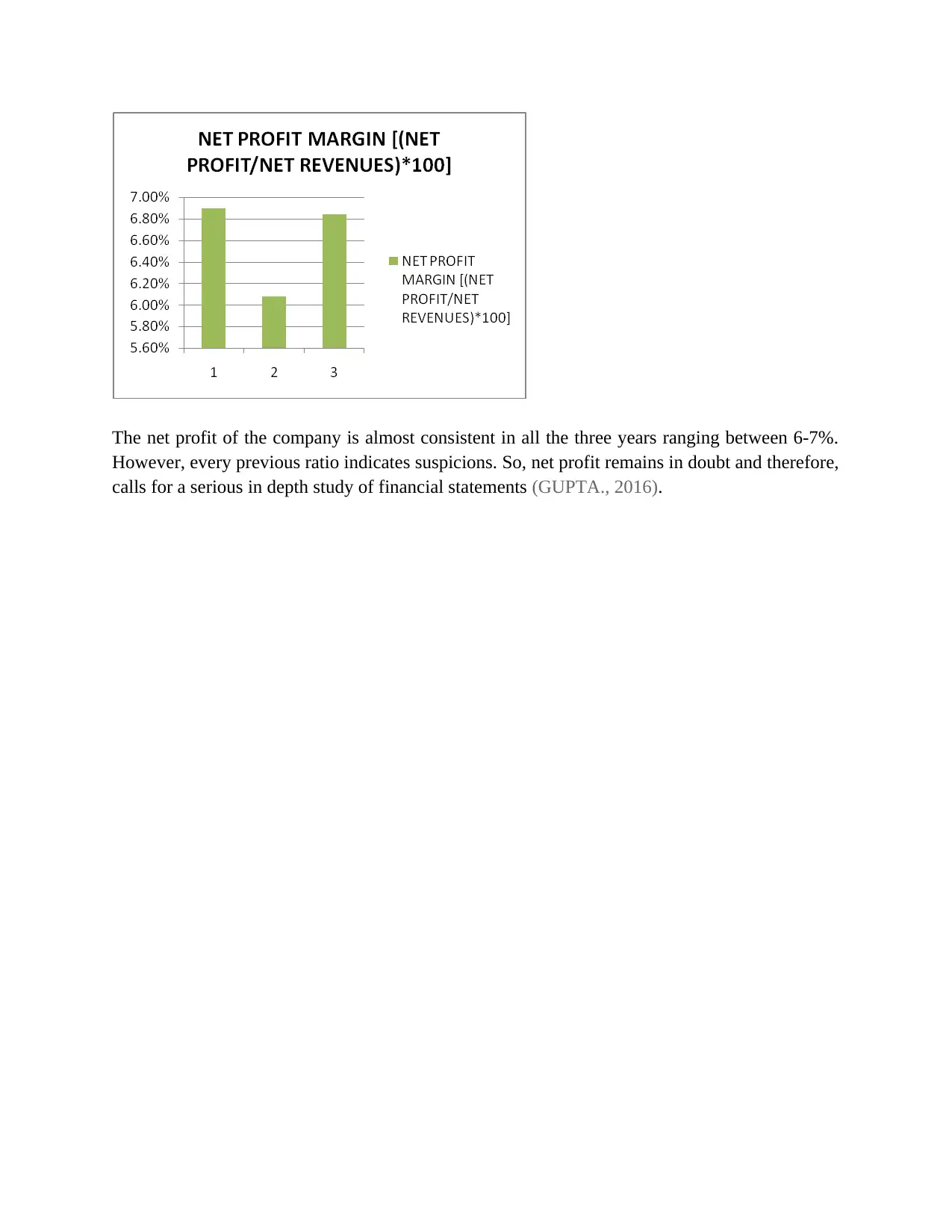
The net profit of the company is almost consistent in all the three years ranging between 6-7%.
However, every previous ratio indicates suspicions. So, net profit remains in doubt and therefore,
calls for a serious in depth study of financial statements (GUPTA., 2016).
However, every previous ratio indicates suspicions. So, net profit remains in doubt and therefore,
calls for a serious in depth study of financial statements (GUPTA., 2016).
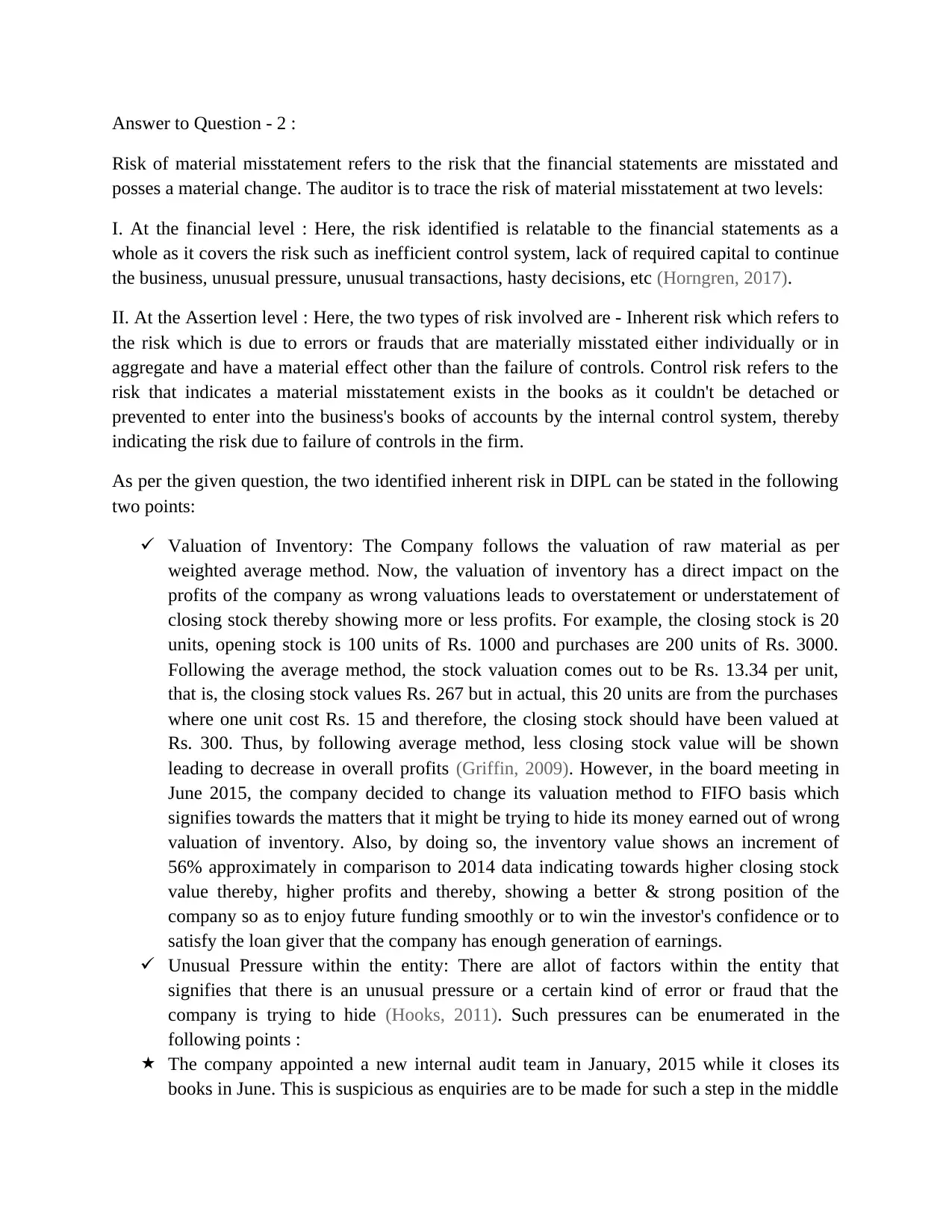
Answer to Question - 2 :
Risk of material misstatement refers to the risk that the financial statements are misstated and
posses a material change. The auditor is to trace the risk of material misstatement at two levels:
I. At the financial level : Here, the risk identified is relatable to the financial statements as a
whole as it covers the risk such as inefficient control system, lack of required capital to continue
the business, unusual pressure, unusual transactions, hasty decisions, etc (Horngren, 2017).
II. At the Assertion level : Here, the two types of risk involved are - Inherent risk which refers to
the risk which is due to errors or frauds that are materially misstated either individually or in
aggregate and have a material effect other than the failure of controls. Control risk refers to the
risk that indicates a material misstatement exists in the books as it couldn't be detached or
prevented to enter into the business's books of accounts by the internal control system, thereby
indicating the risk due to failure of controls in the firm.
As per the given question, the two identified inherent risk in DIPL can be stated in the following
two points:
Valuation of Inventory: The Company follows the valuation of raw material as per
weighted average method. Now, the valuation of inventory has a direct impact on the
profits of the company as wrong valuations leads to overstatement or understatement of
closing stock thereby showing more or less profits. For example, the closing stock is 20
units, opening stock is 100 units of Rs. 1000 and purchases are 200 units of Rs. 3000.
Following the average method, the stock valuation comes out to be Rs. 13.34 per unit,
that is, the closing stock values Rs. 267 but in actual, this 20 units are from the purchases
where one unit cost Rs. 15 and therefore, the closing stock should have been valued at
Rs. 300. Thus, by following average method, less closing stock value will be shown
leading to decrease in overall profits (Griffin, 2009). However, in the board meeting in
June 2015, the company decided to change its valuation method to FIFO basis which
signifies towards the matters that it might be trying to hide its money earned out of wrong
valuation of inventory. Also, by doing so, the inventory value shows an increment of
56% approximately in comparison to 2014 data indicating towards higher closing stock
value thereby, higher profits and thereby, showing a better & strong position of the
company so as to enjoy future funding smoothly or to win the investor's confidence or to
satisfy the loan giver that the company has enough generation of earnings.
Unusual Pressure within the entity: There are allot of factors within the entity that
signifies that there is an unusual pressure or a certain kind of error or fraud that the
company is trying to hide (Hooks, 2011). Such pressures can be enumerated in the
following points :
The company appointed a new internal audit team in January, 2015 while it closes its
books in June. This is suspicious as enquiries are to be made for such a step in the middle
Risk of material misstatement refers to the risk that the financial statements are misstated and
posses a material change. The auditor is to trace the risk of material misstatement at two levels:
I. At the financial level : Here, the risk identified is relatable to the financial statements as a
whole as it covers the risk such as inefficient control system, lack of required capital to continue
the business, unusual pressure, unusual transactions, hasty decisions, etc (Horngren, 2017).
II. At the Assertion level : Here, the two types of risk involved are - Inherent risk which refers to
the risk which is due to errors or frauds that are materially misstated either individually or in
aggregate and have a material effect other than the failure of controls. Control risk refers to the
risk that indicates a material misstatement exists in the books as it couldn't be detached or
prevented to enter into the business's books of accounts by the internal control system, thereby
indicating the risk due to failure of controls in the firm.
As per the given question, the two identified inherent risk in DIPL can be stated in the following
two points:
Valuation of Inventory: The Company follows the valuation of raw material as per
weighted average method. Now, the valuation of inventory has a direct impact on the
profits of the company as wrong valuations leads to overstatement or understatement of
closing stock thereby showing more or less profits. For example, the closing stock is 20
units, opening stock is 100 units of Rs. 1000 and purchases are 200 units of Rs. 3000.
Following the average method, the stock valuation comes out to be Rs. 13.34 per unit,
that is, the closing stock values Rs. 267 but in actual, this 20 units are from the purchases
where one unit cost Rs. 15 and therefore, the closing stock should have been valued at
Rs. 300. Thus, by following average method, less closing stock value will be shown
leading to decrease in overall profits (Griffin, 2009). However, in the board meeting in
June 2015, the company decided to change its valuation method to FIFO basis which
signifies towards the matters that it might be trying to hide its money earned out of wrong
valuation of inventory. Also, by doing so, the inventory value shows an increment of
56% approximately in comparison to 2014 data indicating towards higher closing stock
value thereby, higher profits and thereby, showing a better & strong position of the
company so as to enjoy future funding smoothly or to win the investor's confidence or to
satisfy the loan giver that the company has enough generation of earnings.
Unusual Pressure within the entity: There are allot of factors within the entity that
signifies that there is an unusual pressure or a certain kind of error or fraud that the
company is trying to hide (Hooks, 2011). Such pressures can be enumerated in the
following points :
The company appointed a new internal audit team in January, 2015 while it closes its
books in June. This is suspicious as enquiries are to be made for such a step in the middle
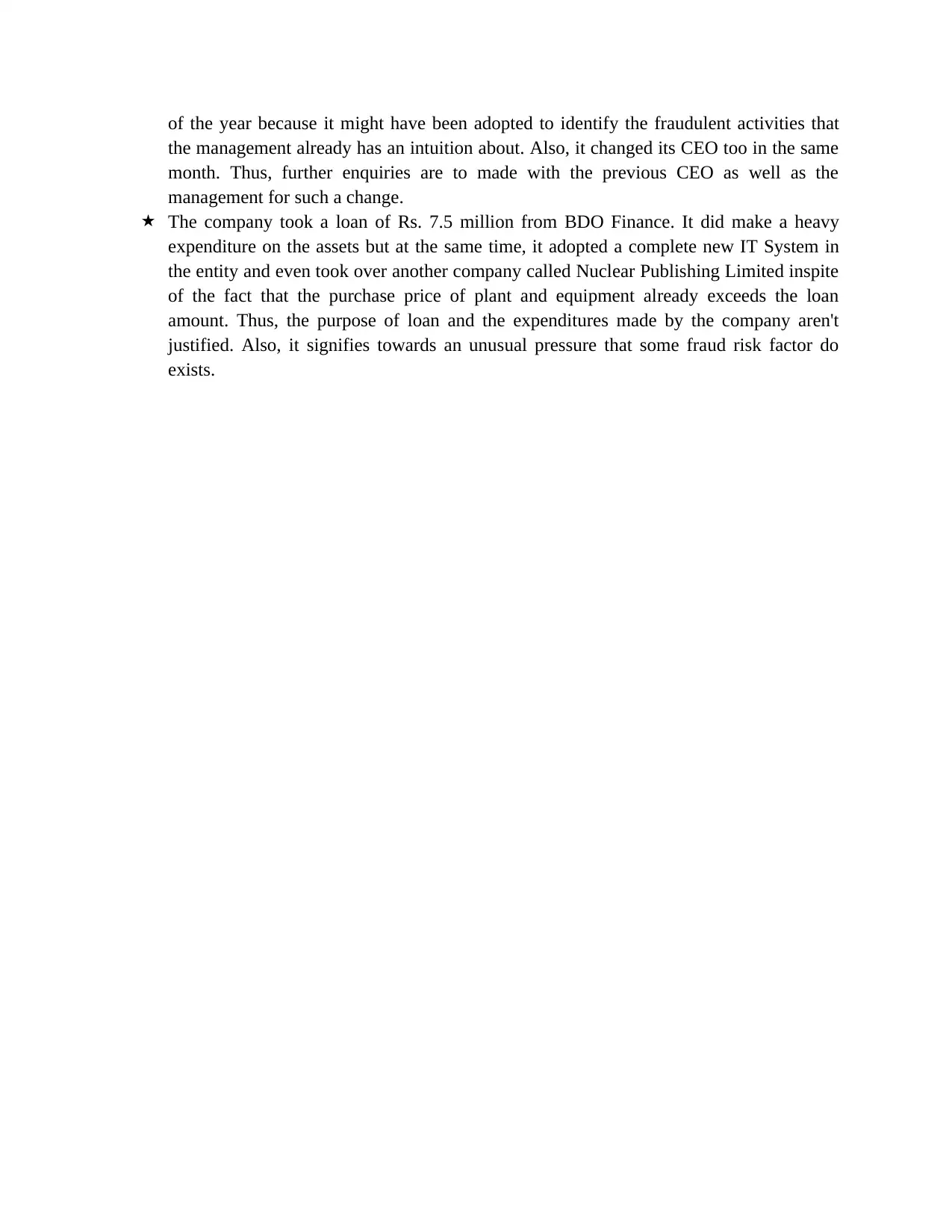
of the year because it might have been adopted to identify the fraudulent activities that
the management already has an intuition about. Also, it changed its CEO too in the same
month. Thus, further enquiries are to made with the previous CEO as well as the
management for such a change.
The company took a loan of Rs. 7.5 million from BDO Finance. It did make a heavy
expenditure on the assets but at the same time, it adopted a complete new IT System in
the entity and even took over another company called Nuclear Publishing Limited inspite
of the fact that the purchase price of plant and equipment already exceeds the loan
amount. Thus, the purpose of loan and the expenditures made by the company aren't
justified. Also, it signifies towards an unusual pressure that some fraud risk factor do
exists.
the management already has an intuition about. Also, it changed its CEO too in the same
month. Thus, further enquiries are to made with the previous CEO as well as the
management for such a change.
The company took a loan of Rs. 7.5 million from BDO Finance. It did make a heavy
expenditure on the assets but at the same time, it adopted a complete new IT System in
the entity and even took over another company called Nuclear Publishing Limited inspite
of the fact that the purchase price of plant and equipment already exceeds the loan
amount. Thus, the purpose of loan and the expenditures made by the company aren't
justified. Also, it signifies towards an unusual pressure that some fraud risk factor do
exists.
Paraphrase This Document
Need a fresh take? Get an instant paraphrase of this document with our AI Paraphraser
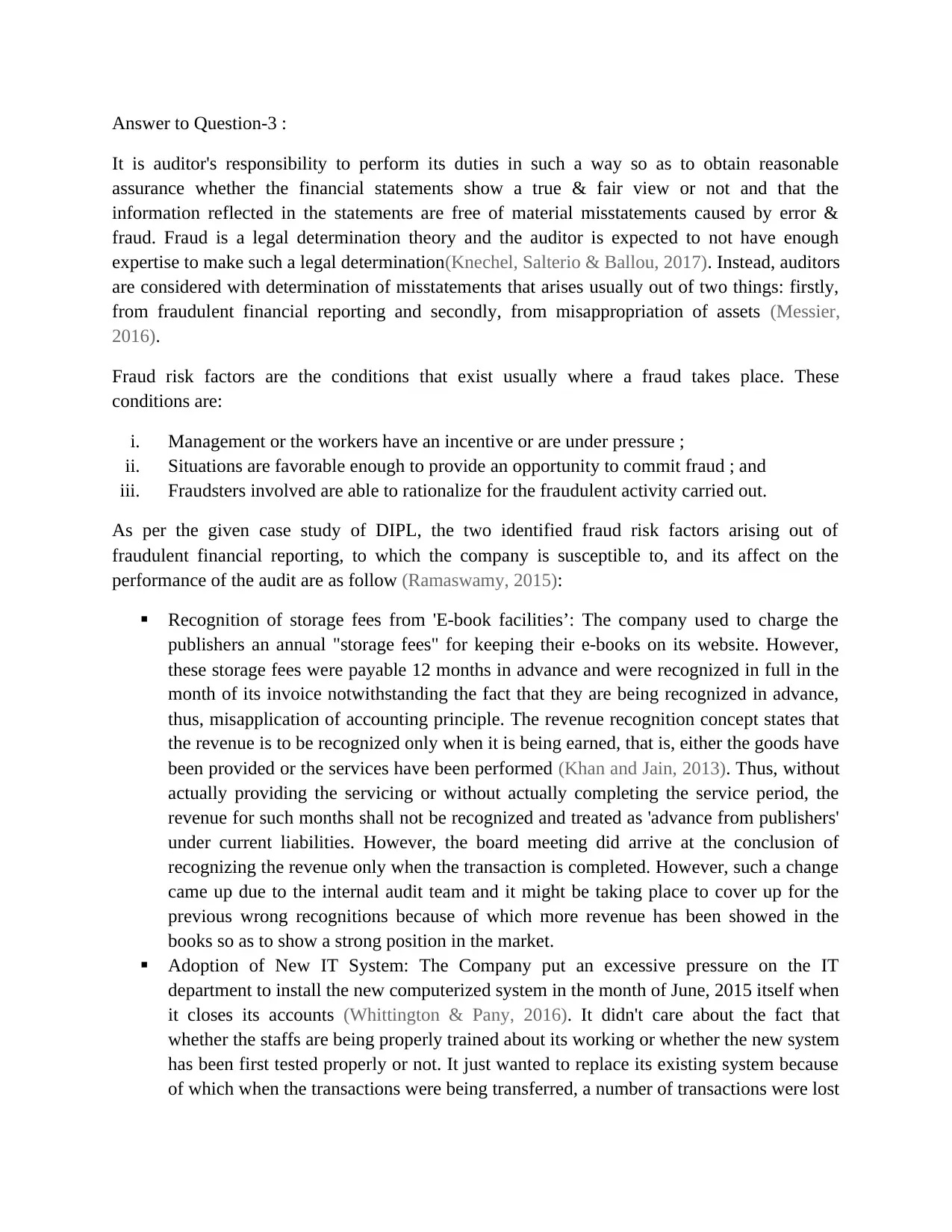
Answer to Question-3 :
It is auditor's responsibility to perform its duties in such a way so as to obtain reasonable
assurance whether the financial statements show a true & fair view or not and that the
information reflected in the statements are free of material misstatements caused by error &
fraud. Fraud is a legal determination theory and the auditor is expected to not have enough
expertise to make such a legal determination(Knechel, Salterio & Ballou, 2017). Instead, auditors
are considered with determination of misstatements that arises usually out of two things: firstly,
from fraudulent financial reporting and secondly, from misappropriation of assets (Messier,
2016).
Fraud risk factors are the conditions that exist usually where a fraud takes place. These
conditions are:
i. Management or the workers have an incentive or are under pressure ;
ii. Situations are favorable enough to provide an opportunity to commit fraud ; and
iii. Fraudsters involved are able to rationalize for the fraudulent activity carried out.
As per the given case study of DIPL, the two identified fraud risk factors arising out of
fraudulent financial reporting, to which the company is susceptible to, and its affect on the
performance of the audit are as follow (Ramaswamy, 2015):
Recognition of storage fees from 'E-book facilities’: The company used to charge the
publishers an annual "storage fees" for keeping their e-books on its website. However,
these storage fees were payable 12 months in advance and were recognized in full in the
month of its invoice notwithstanding the fact that they are being recognized in advance,
thus, misapplication of accounting principle. The revenue recognition concept states that
the revenue is to be recognized only when it is being earned, that is, either the goods have
been provided or the services have been performed (Khan and Jain, 2013). Thus, without
actually providing the servicing or without actually completing the service period, the
revenue for such months shall not be recognized and treated as 'advance from publishers'
under current liabilities. However, the board meeting did arrive at the conclusion of
recognizing the revenue only when the transaction is completed. However, such a change
came up due to the internal audit team and it might be taking place to cover up for the
previous wrong recognitions because of which more revenue has been showed in the
books so as to show a strong position in the market.
Adoption of New IT System: The Company put an excessive pressure on the IT
department to install the new computerized system in the month of June, 2015 itself when
it closes its accounts (Whittington & Pany, 2016). It didn't care about the fact that
whether the staffs are being properly trained about its working or whether the new system
has been first tested properly or not. It just wanted to replace its existing system because
of which when the transactions were being transferred, a number of transactions were lost
It is auditor's responsibility to perform its duties in such a way so as to obtain reasonable
assurance whether the financial statements show a true & fair view or not and that the
information reflected in the statements are free of material misstatements caused by error &
fraud. Fraud is a legal determination theory and the auditor is expected to not have enough
expertise to make such a legal determination(Knechel, Salterio & Ballou, 2017). Instead, auditors
are considered with determination of misstatements that arises usually out of two things: firstly,
from fraudulent financial reporting and secondly, from misappropriation of assets (Messier,
2016).
Fraud risk factors are the conditions that exist usually where a fraud takes place. These
conditions are:
i. Management or the workers have an incentive or are under pressure ;
ii. Situations are favorable enough to provide an opportunity to commit fraud ; and
iii. Fraudsters involved are able to rationalize for the fraudulent activity carried out.
As per the given case study of DIPL, the two identified fraud risk factors arising out of
fraudulent financial reporting, to which the company is susceptible to, and its affect on the
performance of the audit are as follow (Ramaswamy, 2015):
Recognition of storage fees from 'E-book facilities’: The company used to charge the
publishers an annual "storage fees" for keeping their e-books on its website. However,
these storage fees were payable 12 months in advance and were recognized in full in the
month of its invoice notwithstanding the fact that they are being recognized in advance,
thus, misapplication of accounting principle. The revenue recognition concept states that
the revenue is to be recognized only when it is being earned, that is, either the goods have
been provided or the services have been performed (Khan and Jain, 2013). Thus, without
actually providing the servicing or without actually completing the service period, the
revenue for such months shall not be recognized and treated as 'advance from publishers'
under current liabilities. However, the board meeting did arrive at the conclusion of
recognizing the revenue only when the transaction is completed. However, such a change
came up due to the internal audit team and it might be taking place to cover up for the
previous wrong recognitions because of which more revenue has been showed in the
books so as to show a strong position in the market.
Adoption of New IT System: The Company put an excessive pressure on the IT
department to install the new computerized system in the month of June, 2015 itself when
it closes its accounts (Whittington & Pany, 2016). It didn't care about the fact that
whether the staffs are being properly trained about its working or whether the new system
has been first tested properly or not. It just wanted to replace its existing system because
of which when the transactions were being transferred, a number of transactions were lost

in this process (PAVAN, 2014). This action of management indicates towards the
existence of fraud risky factors as if some fraudulent activity has been undertaken and
with the fear of internal audit team who would be definitely able to rectify it, the
management thought of replacing the entire system so as to hide the transactions and
claim it to transactions lost due to less knowledge or inefficiency of the accounting & IT
department. Also, the same action serves as an opportunity to the employees or the other
members who may take an advantage of messed up accounts and thereby, misappropriate
the cash balances or conduct any such activity that would lead to personal earnings on
account of the organization and later on, blame the department for being so careless
regarding the transfer of accounts (Pitt, 2014).
existence of fraud risky factors as if some fraudulent activity has been undertaken and
with the fear of internal audit team who would be definitely able to rectify it, the
management thought of replacing the entire system so as to hide the transactions and
claim it to transactions lost due to less knowledge or inefficiency of the accounting & IT
department. Also, the same action serves as an opportunity to the employees or the other
members who may take an advantage of messed up accounts and thereby, misappropriate
the cash balances or conduct any such activity that would lead to personal earnings on
account of the organization and later on, blame the department for being so careless
regarding the transfer of accounts (Pitt, 2014).

References
Basu, S. (2009). Fundamentals of auditing. Delhi: Pearson.
Blank, R. (2014). The Basics of Quality Auditing. Hoboken: Taylor and Francis.
Boynton, W., & Johnson, R. (2006). Modern Auditing. Hoboken: John Wiley and Sons.
Cahill, L., & Kane, R. (2011). Environmental health and safety audits. Lanham,
MD:Government Institutes.
Griffin, M. (2009). MBA fundamentals. New York, NY: Kaplan.
GUPTA. (2016). FINANCIAL ACCOUNTING FOR MANAGEMENT. [S.l.]: PEARSON
EDUCATION INDIA.
Horngren, C., Datar, S. and Rajan, M. (2017). Horngren's cost accounting. Harlow, Essex,
England: Pearson Education Limited.
Hooks, K. (2011). Auditing and assurance services. Hoboken, NJ: Wiley.
Knechel, W., Salterio, S., & Ballou, B. (2017). Auditing. New York: Routledge.
Messier, W. (2016). Auditing & assurance services. [Place of publication not identifiedMcgraw-
Hill Education.
Khan, M. and Jain, P. (2013). Management accounting. New Delhi, India: McGraw-Hill
Education (India).
Kumar, P. (2014). CA-IPCC Auditing and Assurance. Delhi, India: S. Chand Publishing.
Pitt, S. (2014). Internal audit quality. Hoboken: Wiley.
Ramaswamy, M. (n.d.). Finance for nonfinancial managers.
Whittington, O., & Pany, K. (2016). Principles of auditing & other assurance services.
NewYork, N.Y.: McGraw-Hill Education.
Basu, S. (2009). Fundamentals of auditing. Delhi: Pearson.
Blank, R. (2014). The Basics of Quality Auditing. Hoboken: Taylor and Francis.
Boynton, W., & Johnson, R. (2006). Modern Auditing. Hoboken: John Wiley and Sons.
Cahill, L., & Kane, R. (2011). Environmental health and safety audits. Lanham,
MD:Government Institutes.
Griffin, M. (2009). MBA fundamentals. New York, NY: Kaplan.
GUPTA. (2016). FINANCIAL ACCOUNTING FOR MANAGEMENT. [S.l.]: PEARSON
EDUCATION INDIA.
Horngren, C., Datar, S. and Rajan, M. (2017). Horngren's cost accounting. Harlow, Essex,
England: Pearson Education Limited.
Hooks, K. (2011). Auditing and assurance services. Hoboken, NJ: Wiley.
Knechel, W., Salterio, S., & Ballou, B. (2017). Auditing. New York: Routledge.
Messier, W. (2016). Auditing & assurance services. [Place of publication not identifiedMcgraw-
Hill Education.
Khan, M. and Jain, P. (2013). Management accounting. New Delhi, India: McGraw-Hill
Education (India).
Kumar, P. (2014). CA-IPCC Auditing and Assurance. Delhi, India: S. Chand Publishing.
Pitt, S. (2014). Internal audit quality. Hoboken: Wiley.
Ramaswamy, M. (n.d.). Finance for nonfinancial managers.
Whittington, O., & Pany, K. (2016). Principles of auditing & other assurance services.
NewYork, N.Y.: McGraw-Hill Education.
1 out of 10
Related Documents
Your All-in-One AI-Powered Toolkit for Academic Success.
+13062052269
info@desklib.com
Available 24*7 on WhatsApp / Email
![[object Object]](/_next/static/media/star-bottom.7253800d.svg)
Unlock your academic potential
© 2024 | Zucol Services PVT LTD | All rights reserved.





